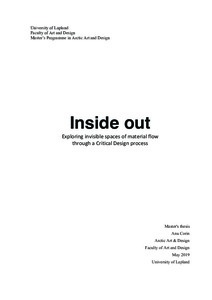Inside out. Exploring invisible spaces of material flow through a critical design process
Corin, Anu (2019)
Corin, Anu
Lapin yliopisto
2019
Julkaisun pysyvä osoite on
https://urn.fi/URN:NBN:fi-fe2019061820951
https://urn.fi/URN:NBN:fi-fe2019061820951
Tiivistelmä
This thesis is a creative exploration of sustainability and design, investigating different aspects of materiality and how critical design could be used as a method for understanding the material flow and identifying value opportunities. Through a collaboration project between University of Lapland and Westenergy, waste-to-energy plant located in Western Finland, the thesis is identifying invisible spaces of material flow and discussing how they could be communicated, made visible and understood.
By studying the link between human, material and environment, the aim is also to understand how to work as a designer in this changing world. The thesis is describing the complex issue of creating for sustainability, thus discussing the role of design in shaping a sustainable future. The study is drawing on design research methodology, supported by reflexive research and practice-based approaches such as workshop. Through identifying patterns, topics and themes in the data, the analysis is recognizing opportunities for communicating transparency. The collaboration project is including three creative processes, each building on the previous one, functioning as a vehicle for the research.
The study argues that a reason to environmental alienation is that parts of the material flow are hidden to most people and therefore difficult to trace. These gaps could be visualized and understood through methods of critical design. The thesis is opening up the possibility for further research on how critical design could be applied as a service design method and on developing activities directed to design for sustainability.
By studying the link between human, material and environment, the aim is also to understand how to work as a designer in this changing world. The thesis is describing the complex issue of creating for sustainability, thus discussing the role of design in shaping a sustainable future. The study is drawing on design research methodology, supported by reflexive research and practice-based approaches such as workshop. Through identifying patterns, topics and themes in the data, the analysis is recognizing opportunities for communicating transparency. The collaboration project is including three creative processes, each building on the previous one, functioning as a vehicle for the research.
The study argues that a reason to environmental alienation is that parts of the material flow are hidden to most people and therefore difficult to trace. These gaps could be visualized and understood through methods of critical design. The thesis is opening up the possibility for further research on how critical design could be applied as a service design method and on developing activities directed to design for sustainability.
Kokoelmat
- Pro gradu -tutkielmat [4897]
